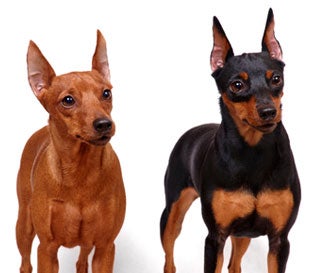Learn about dog breeds
Detailed information & photos on over 190 different breeds
Description
Even though the Miniature Pinscher looks a lot like simply a smaller version of the Doberman Pinscher, it is actually not related to the Doberman. The Miniature Pinscher is a small dog with sturdy musculature and strong, squared proportions. He has a narrow, flat skull and prominent face with high ears. The ears and tail of the breed are sometimes docked or medically cut. The dog's eyes are small and ovular in shape. Their nose and mouth area has a very strong appearance, and their noses are black, except in chocolate colored Miniature Pinschers where the nose is chocolate colored. He has a slightly arched neck and sloped back, strong short legs and very small feet.
Coat Description
The miniature Pinscher has a short coat that is smooth, not coarse. His fur is the same length over his entire body.
The Miniature Pinscher can be all red, red with black, black with red markings, or chocolate, which is a deep brown color. Chocolate Miniature Pinschers often have red markings similar to those seen in the black versions. Miniature Pinschers in the United Kingdom can also be blue. No Miniature Pinscher can have any white markings.
History
Originally bred from the German Pinscher and the Italian Greyhound as a rat hunter used in stables, the Miniature Pinscher is a German breed of dog. He was bred with the Dachshund to produce his miniature size. It is commonly thought that the Miniature Pinscher is a small version of the Doberman Pinscher when in fact the Doberman was bred to be a larger version of the Miniature Pinscher. The dogs do have a common ancestor in the German Pinscher. The Miniature Pinscher breed was first noted in the nineteenth century, and was introduced outside Germany in the late nineteenth century. He was brought to the United States in the early twentieth century.
Temperament
Miniature Pinschers have a gentle disposition, but can be stubborn and demanding. Spoiling the dog will make his temperament worse, so begin training as early as possible. The breed has a lot of energy and is very proud. The Miniature Pinscher is much stronger and better built than most small breed dogs, especially most miniature dogs, but children should be supervised around them so they do not accidentally hurt the dog. Also, children should be aware that Miniature Pinschers should not be taunted. The Miniature Pinscher can be aggressive with other dogs. If introduced as puppies, the Miniature Pinscher can grow to live well with another dog. The miniature Pinscher is a very protective animal and is suspicious of people he doesn’t know. Socializing the dog at a young age will help him overcome his suspicions of strange people. The miniature Pinscher is a smart dog and once you have established yourself as the master, the dog will be eager to learn training and obedience behaviors. The breed, once well trained and well behaved, is a playful pet and a very good companion, particularly for one owner.
Health Problems
Miniature Pinschers are prone to overeating and, as a result, also tend to be obese. The major problems with canine obesity are joint problems and shorter life spans for the dog. Other than obesity, the Miniature Pinscher does not have any other well documented health problems or even any common congenital illnesses.
Grooming
Because the breed does shed a little, the dog should be given a regular grooming treatment. By using a stiff bristle brush on the Miniature Pinscher a few times each week, and using a damp cloth to remove loose hair, the owner can easily keep the dog groomed. If the dog is a competition or show dog, he must have his ears and his tail surgically docked.
Exercise
This breed has a lot of energy, and also is prone to obesity. As such, the Miniature Pinscher does best physically and temperamentally when he has regular daily exercise. His exercise sessions can be as simple as a walk around the park, but the owner should be aware that the dog is susceptible to climate changes and should not be outside in extremely hot or extremely cold weather for any extended period of time.
Training
Like many breeds, the Miniature Pinscher must first be established as lower in the pack order than the owner. Once he recognizes the owner as the alpha dog, he will be easier to train and more eager to obey commands. He likes to be trained and likes to learn. Training methods should never include physical punishment or harsh voice reprimands; this can cause the dog to become afraid and make him shy or skittish. Miniature Pinschers do very well in puppy classes, where they are socialized with other dogs and with other people at an early age. Socialization helps the breed overcome any fear of strangers. The dog responds well to crate training methods in order to learn to be housebroken. Some people also use paper training for the dog, and this can be good for owners who live where climates are extreme and there are times when the dog cannot go outside. Early training should address any excessive barking in the breed, as well as digging and jumping behaviors.
Advertise | Privacy Policy | Terms of Use | Contact Us © Copyright 2004-2024 PupCity.com. All rights reserved.
